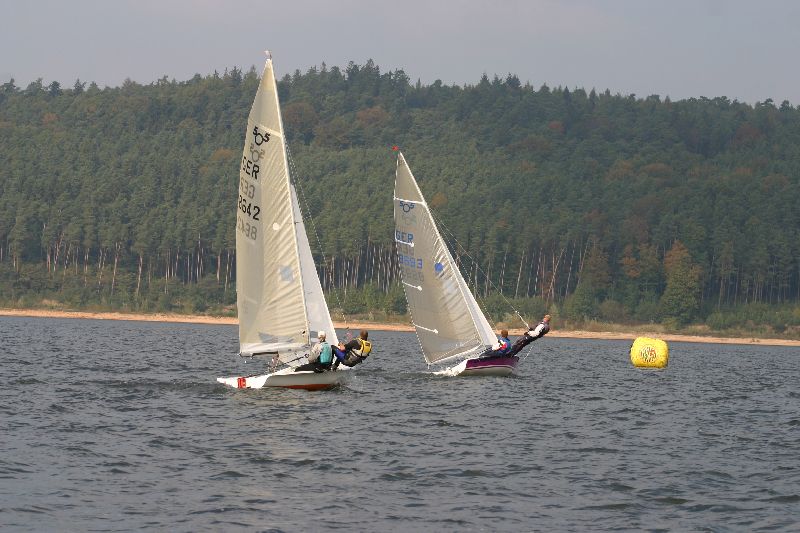- 505 (dinghy)
Infobox Sailboat Specifications
playername = International 505
class_symbol =
numberofcrew = Two (single trapeze)
loa = 5050 mm (16 ft 5 in)
lwl =
beam = 1880 mm (6 ft 2 in)
draft = 1066 mm (3 ft 6 in)
hull = 127.4 kg (280.9 lb)
mastheight =
mainsailandjib= 14 msu|p=2 (151 ftsu|p=2)
spinnaker = 26 msu|p=2 (280 ftsu|p=2)
dpn = 79.9
phrf = 149.4
updated = The International 505 is aone-design high-performance two-personmonohull planing centerboarddinghy . Utilizing a trapeze for the crew, it is a physically demanding boat.The genesis of the class began in
1953 with the creation of the 'Coronet' dinghy designed by John Westell. This sailboat competed for the two-person performance dinghy classification for the Olympics at the International Yacht Racing Union (IYRU) trials of 1953 held at La Baule, France. In1954 , theCaneton Association of France requested John Westell to make significant changes to the design to suit their needs. This reduced the overall length, weight and reduced the sail area to become the 505, so named for its length of 5.05 meters. The class achieved international status with the IYRU in1955 .The class is a popular international class and is actively raced in 18 countries around the world. World championships are held every year at rotating by continent locations around the world, and attract in excess of 100 boats on the start line. At the
2005 world championships held inWarnemünde , Germany there were 171 boats.The design of the boat's hull shape and sailplan are tightly controlled, while the
spar s, foils and disposition of the rigging is open. This allows the boats to be set up to the needs of the sailor, rather than controls established by the class association, resulting in a high level of adaptability to sailing styles. There are a number of successful sail/layout combinations.As of 2005, there are 14 known builders throughout the world. Construction materials range from fiberglass/polyester to carbon fiber, with just about every conceivable construction material used at one time or another within the class. Modern boats with modern materials are capable of remaining competitive at the international level for ten years or more. As of 2007, over 8,900 505s had been built since 1954.
Various modifications to the accepted design outside of the class rules have been conducted at different points in history. Such modifications have included setting up a double trapeze system, installation of a bowsprit, and inclusion of an asymmetric spinnaker. The most recent of these modifications have been made by Mike Arnold of the
Deben Yacht Club in Woodbridge, UK, who has been experimenting with a 505 hull and rig modified to have a higher boom (i.e. a cut down main) and an asymmetric spinnaker that flies from a moveable bowsprit. This may be the genesis of a new class known as the "Alto".External links
* [http://www.int505.org/ Official class website]
* [http://www.int505.org/r-MEASUR.htm measurement rules]
* [http://www.505worlds2007.com/ 2007 World Championships]
* [http://hem.passagen.se/waterat/505_has_verve.htm review]
* [http://sandgateyachtclub.googlepages.com/home Sandgate Yacht Club 505 Sailing]Other classes of dinghy
Wikimedia Foundation. 2010.
